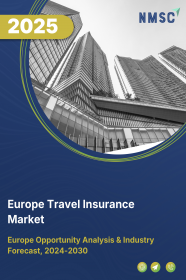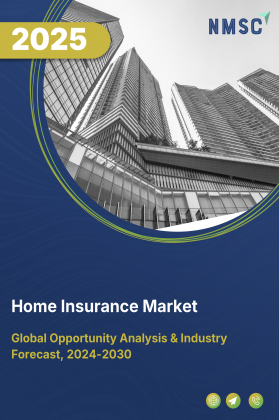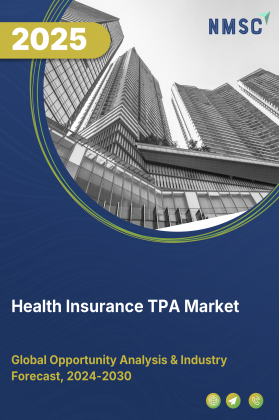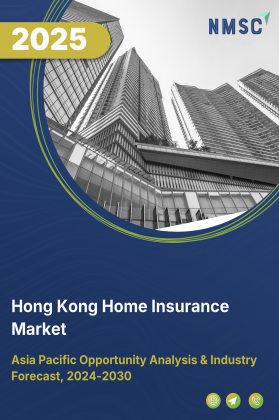
Europe Travel Insurance Market by Age (Millennials, Generation X, and Baby Boomers), by Income Level (Low-income travelers, Middle-income travelers and High-Income Travelers), by Coverage (Medical Coverage, Trip Cancellation Coverage, Baggage and Personal Belongings Coverage, Accidental Death and Dismemberment (AD&D) Coverage and Others– Opportunity Analysis and Industry Forecast, 2024–2030
Industry: BFSI | Publish Date: 18-Sep-2025 | No of Pages: 209 | No. of Tables: 193 | No. of Figures: 138 | Format: PDF | Report Code : BF1975
Market Overview
The Europe Travel Insurance Market size was valued at USD 6.51 billion in 2023 and is predicted to reach USD 14.56 billion by 2030, with a CAGR of 11.1 % from 2024 to 2030. Travel insurance is a specialized form of insurance intended to provide protection and coverage to travelers against a diverse range of potential risks and unforeseen circumstances that may arise before or during their journeys. It plays a crucial role in mitigating the financial impact of various travel-related emergencies, disruptions, and inconveniences, thereby offering travelers peace of mind and assurance throughout their trips.
One of its primary benefits is its ability to provide financial reimbursement and assistance in the event of trip cancellations or interruptions. This coverage encompasses unforeseen situations such as illness, injury, or emergencies, enabling travelers to recover non-refundable expenses associated with flights, accommodations, and other pre-paid arrangements.
Embedded Digital Platforms and Ai-driven Personalization Accelerate Market Penetration
Europe’s travel insurance market is increasingly propelled by seamless integration of insurance into consumers’ travel planning workflows. Embedded insurance—where coverage options appear directly during flight, hotel, or tour bookings has surged in popularity, simplifying access and boosting adoption across all traveler segments. At the same time, artificial intelligence and machine learning are enabling hyper-personalized policies through real-time risk assessments, dynamic pricing, and tailored coverage enhancements. Insurers now leverage data analytics not just for risk evaluation but also to deliver individualized recommendations and faster, smarter claims processing. Together, these digital innovations are expanding reach—especially among tech-savvy and underserved traveler groups—by making travel insurance intuitive, responsive, and integrated into everyday booking experiences.
Elevated Risk Perception Fuels Demand for Premium & Parametric Coverage
Recent global travel disruptions—ranging from airline delays and natural disasters to geopolitical instability—have heightened traveler sensitivity to trip risks. As a result, there's a noticeable increase in demand for insurance policies that go beyond standard protection, such as “Cancel For Any Reason” options and parametric insurance models that trigger automatic payouts based on events like flight delays or severe weather. Parametric products, which eliminate cumbersome claims procedures, are gaining traction with travelers seeking faster, more reliable compensation. This trend is particularly pronounced during peak travel seasons, where uncertainty drives travelers—and insurers—to prioritize robust, premium-grade coverage solutions.
Complex Cross-border Regulatory Compliance Increases Operational Burden
One of the key restraints in Europe’s travel insurance market is the operational complexity created by varying regulations across different countries. While EU directives provide a degree of harmonization, individual member states still maintain unique compliance requirements, documentation standards, and consumer protection rules. For insurers operating across multiple jurisdictions, this means adapting policies, disclosures, and claims procedures to meet diverse legal frameworks, which can significantly increase administrative costs and slow down product launches. The challenge is amplified when catering to both intra-European and international travelers, as coverage terms must account for multi-country itineraries and align with the insurance mandates of non-EU destinations. These regulatory variations often limit insurers’ ability to scale digital offerings uniformly, create pricing inconsistencies, and can discourage smaller players from expanding regionally—ultimately constraining market growth.
Expansion of Parametric Insurance Models Enhances Speed and Reliability Of Payouts
The rise of parametric insurance offers a transformative growth avenue for Europe’s travel insurance market. Unlike traditional policies that require lengthy claims assessments, parametric models trigger automatic payouts when predefined events—such as flight delays, extreme weather, or natural disasters—are verified through trusted data sources. This eliminates cumbersome documentation, reduces settlement timelines to hours or even minutes, and delivers a more transparent customer experience. With European travelers increasingly seeking certainty and speed in compensation, particularly during peak travel seasons and in high-disruption scenarios, parametric products can significantly boost consumer trust and adoption rates. For insurers, these models also lower administrative costs, minimize disputes, and enable scalable offerings across diverse travel segments. As digital booking platforms and travel aggregators integrate real-time data feeds, the expansion of parametric coverage is poised to become a competitive differentiator and a catalyst for market growth in the coming years.
UK Holds a Dominant Share in the Europe Market
The UK holds a dominant share in the Europe market for various reasons. Firstly, as one of the largest economies in Europe, the UK boasts a significant volume of outbound travelers, contributing to the demand for travel insurance. Additionally, the UK has a well-developed insurance industry with a wide range of insurance providers offering competitive travel insurance products.
Moreover, the UK's strong travel culture, coupled with a high level of awareness about the importance of travel insurance, further fuels market growth. Furthermore, the presence of major international airports and transportation hubs in the UK facilitates travel and increases the need for insurance coverage among travelers. Overall, these factors contribute to the UK's dominant position in the Europe travel insurance market.
Netherlands is Expected to Show Steady Growth in the Europe Market
The Netherlands is expected to show steady growth in the Europe market for several reasons. Firstly, the Netherlands boasts a stable economy with a high standard of living, leading to a growing number of outbound travelers. This increasing trend in travel creates a greater awareness and demand for travel insurance among Dutch travelers, driving market growth.
Additionally, the Netherlands has a well-developed insurance sector with innovative products and services tailored to meet the needs of travelers. Furthermore, the Dutch government actively promotes tourism and travel, contributing to the expansion of the travel insurance market.
Moreover, the Netherlands' strategic location as a transportation hub within Europe enhances its position in the travel insurance market. Overall, these factors combined suggest that the Netherlands is poised for steady growth in the Europe travel insurance market.
Competitive Landscape
Several market players operating in the Europe travel insurance market include Allianz Partners SAS, AXA Partners SA, Europ Assistance SA (Generali Group), Cover-More Group Ltd (Zurich), Chubb European Group SE (Chubb), ERGO Reiseversicherung AG (Munich Re), MAWDY SL (MAPFRE), HCC International Insurance Co PLC (Tokio Marine), Aviva Plc, Starr International, Ageas NV Group, RSA Insurance Group Limited, Vienna Insurance Group, Sompo Holdings, Travel Insurance Facilities Plc.
Europe Travel Insurance Market Key Segments
By Age
-
Millennials
-
Generation X
-
Baby Boomers
By Income Level
-
Low-income Travelers
-
Middle-income Travelers
-
High-income Travelers
By Coverage
-
Medical Coverage
-
Trip Cancellation Coverage
-
Baggage and Personal Belongings Coverage
-
Accidental Death and Dismemberment (AD&D) Coverage
By Days of Coverage
-
Short-Trip Insurance
-
Standard Trip Insurance
-
Extended Trip Insurance
-
Multi-Trip Insurance
By Distributional Channel
-
Insurance Companies
-
Banks
-
Airlines
-
Online Platforms
-
Insurance Aggregators and Comparison Websites
-
Travel Agents and Tour Operators
By End User
-
Pilgrim Travelers
-
Education Travelers
-
Business Travelers
-
Family Travelers
By Country
-
The UK
-
Germany
-
France
-
Italy
-
Spain
-
Denmark
-
Netherlands
-
Finland
-
Sweden
-
Norway
-
Russia
-
Rest of Europe
KEY PLAYERS
-
Allianz Partners SAS
-
AXA Partners SA
-
Europ Assistance SA (Generali Group)
-
Cover-More Group Ltd (Zurich)
-
Chubb European Group SE (Chubb)
-
ERGO Reiseversicherung AG (Munich Re)
-
MAWDY SL (MAPFRE)
-
HCC International Insurance Co PLC (Tokio Marine)
-
Aviva Plc
-
Starr International
-
Ageas NV Group
-
RSA Insurance Group Limited
-
Vienna Insurance Group
-
Sompo Holdings
-
Travel Insurance Facilities Plc
REPORT SCOPE AND SEGMENTATION:
|
Parameters |
Details |
|
Market Size in 2023 |
USD 6.51 Billion |
|
Revenue Forecast in 2030 |
USD 14.56 Billion |
|
Growth Rate |
CAGR of 11.1 % from 2024 to 2030 |
|
Analysis Period |
2023–2030 |
|
Base Year Considered |
2023 |
|
Forecast Period |
2024–2030 |
|
Market Size Estimation |
Billion (USD) |
|
Growth Factors |
|
|
Countries Covered |
12 |
|
Companies Profiled |
15 |
|
Market Share |
Available for 10 companies |
|
Customization Scope |
Free customization (equivalent up to 80 working hours of analysts) after purchase. Addition or alteration to region, regional, and segment scope. |
|
Pricing and Purchase Options |
Avail customized purchase options to meet your exact research needs. |




















 Speak to Our Analyst
Speak to Our Analyst

























